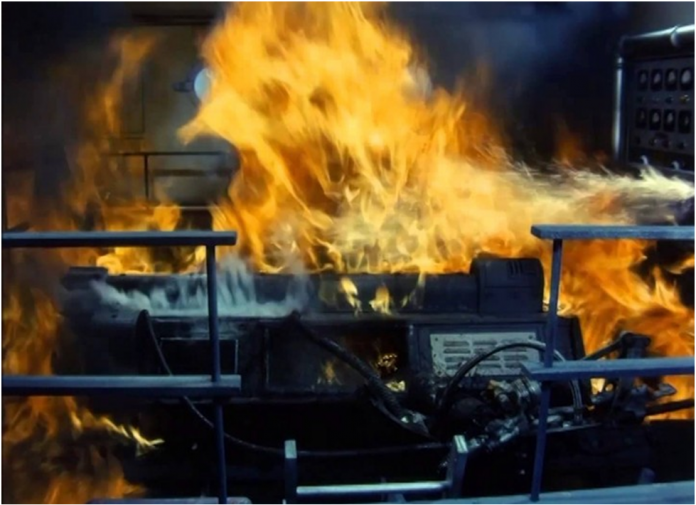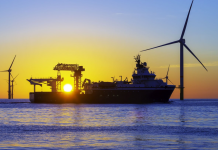
The year was 1985.
At this time I was running my own consulting company and with my previous work experience on the development of fire detection systems, together with one of the Salen subsidiary companies, and with participation of Lloyd Register, I had good relations with them, the Swedish Shipowners Association and the maritime association on preventive fire protection.
Sweden had at the time a Fire Protection Commission consisting of people from the shore-based fire departments, the Maritime Administration and other maritime related organizations including the Unions. This Commission was responsible for the fire protection training of seagoing personal, but they also had other ambitions.
In 1985, they looked into their balance sheet, and they decided to spend some money looking into fire research. I became the man they picked to head up this work, and the first thing I did was to develop a program describing what to best spend their money on.
My research is a long story, but the turnout was that oil spray fires were the most common reason for an engine room fire to start. These could spread to the cofferdam and cause an even more dangerous pool fire. Based on my report we started to work on two things:
1. Installation issues in ships.
To build with hot oil pipe flanges above a steam pipe was not a good idea, and we also found bad installations on medium speed engines that the classification societies picked up for their Rule Books
2. New medium Speed Engines.
At the time of 1985 the major manufacturers of medium speed engines developed their products for heavier oil: 180 but even 360 were advertised and installed in ships.
Unfortunately this resulted in frequent fuel pipe problems and several incidents were recorded. Burning heavier fuel, the engines vibrated a lot more more than we were used to and pipe leakage became more and more common. Spray fires that started slowly soon spread down to the cofferdam after which the situation could become really serious.
At the time we started this project some shipowners still installed Halon systems for local fire protection and quite a few had installed Halon even as the total flooding system in their engine rooms. Halon had turned out to be more and more popular, because it did not kill people at an early release. Actually, it was the perfect agent for fire extinction that saved many lives. But at the end of the decade, politicians become more and more interested in the ozone layer and Halon became banned.
So, what could the shipping industry do? For total flooding they went back to using CO2 which was supposed to be somewhat more environmentally friendly, but unfortunately it killed people that were not evacuated from the engine room in time.
To use CO2 for total flooding was to go back 10 years or more in time and to accept a higher fire risk as well as a higher risk for the crew onboard. Everybody knew that the CO2 was not released until all crew had been counted and at that time it was often too late for the CO2 to produce its expected effect.
So the most important and interesting part of this project became the development of a “Local Fire Protection System” that could, if possible automatically, kill a local fire before it spread to such a serious level that CO2 would have to be used. And what was our alternative if not water, if necessary injected with a fire protection agent.
To use water to extinguish an oil fire was, for some people, a little odd, but after several investigations we decided to test it.
Within the framework of the basic investigation together with “Statens Provningsanstalt” in the Swedish Laboratory Borås. In the report of 1989:52 we defined in detail how we wanted to perform tests of such a system.
Initial reference inspections and tests were done in four RO-Ro passenger ships sailing the Baltic Sea. The results showed that spray fires could occur during operation on heavy fuel oil and temperatures up to 460C were measured on components that could easily be reached by a spray of 360 oil. During operation on a lower grade oil the fire risks increased tremendously and the most dangerous operation in an engine room was of course auxiliary engines.
Based on this we decided to do full scale laboratory tests. We built up a test rig consisting of a diesel engine mockup and an oil heating and spraying station that sprayed oil of different grade and temperatures on a big temperature controlled heat plate installed on the top of a mockup.
We probably did more than 50 tests which are documented in a separate report.
Before the major tests, was started an evaluation of the oils to be used. They were tested in a specially designed “Fire Place” in which the different oil sprays were compared as per for example combustion efficiency, smoke potential and heat value during combustion in the form of spray. This gave us a basic idea of whether water could be used to replace Halon in local protection systems and how and where to install them. The development of efficient nozzles was not a part of this project.
Any company that believed in our tests was welcome to do their own development work.
During the tests we used a few standard ordinary sprinkler nozzles. Our aim with the project was to prove that a water based system combined with the correct type of fire detectors could replace a Halon-based system as a local protection system in areas where the fire risk is high.
The results turned out very positive and I read a paper and showed several results in color pictures during the Seatrade Conference in Miami 1992. Interest was unexpectedly low. In the IMO’s Fire Protection Group, on the other hand, we had already received great encouragement. The interest was overwhelming.
At the end of the time we worked on the project a young man turned up. His name was Göran Sundholm and he worked his own test programs. Sundholm had a company named “Maritime and Offshore” working mainly on cleaning of hydraulic oil, but he had for some reason started to look into fire protection using water at high pressure and he was spending his time on working to develop high pressure water mist nozzles for various purposes on a ship.
His major interest at the time was the interior of passenger ships with priority on passenger cabins, but after some time he turned his attention to the engine rooms. He became very successful, and he changed the name of his company to Marioff. He developed nozzles for various applications – after some time also for local protection systems in engine rooms. He designed a module for local protection of high-risk areas and soon he had a class and SOLAS accepted system that became mandatory.
Source – THE MARITIME EXECUTIVE




